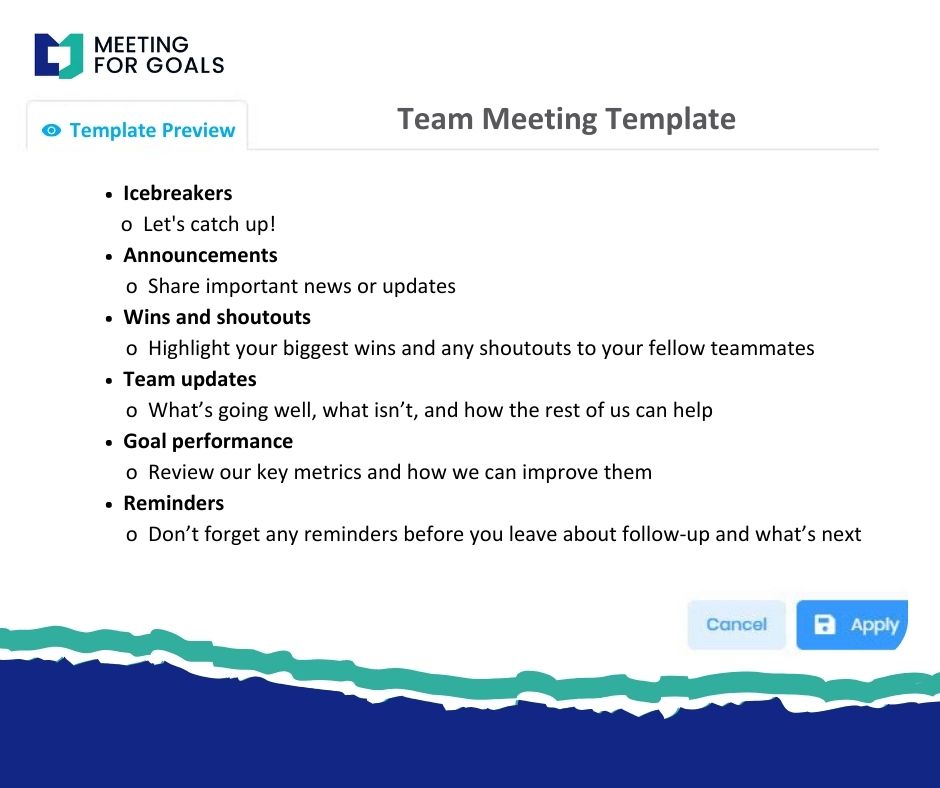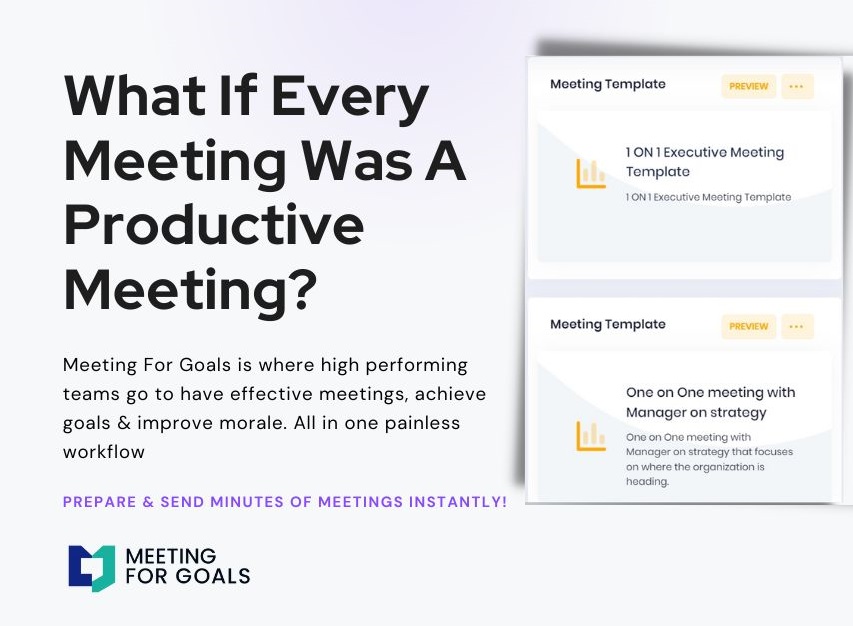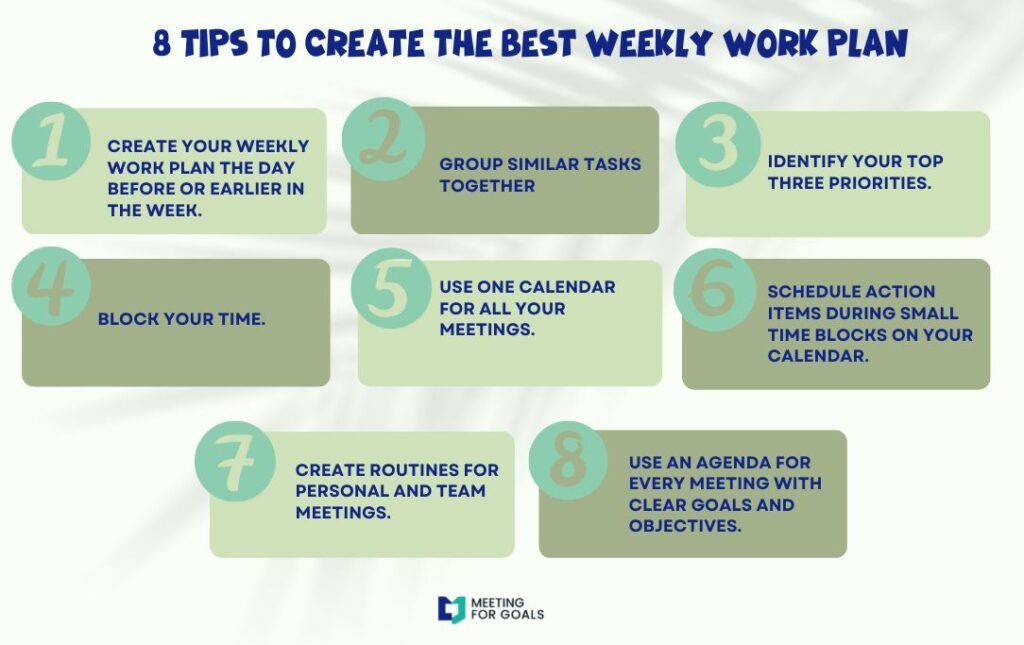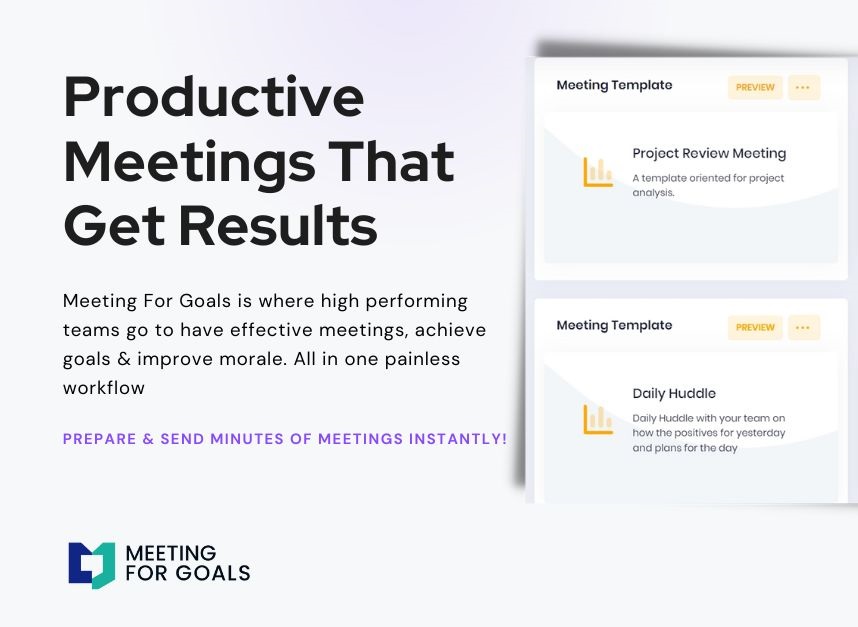Group Decision-Making Techniques to Supercharge Your Team Meetings
Introduction
Meetings are where ideas take shape. They are also where strategies are crafted and critical decisions are made. But let’s be honest—too often, meetings feel like a waste of time. They can drag on, go off-topic, and end without clear outcomes. Sound familiar?
If you’re leading a high-performing team in a mid-sized company (think 40–70 employees), making the right decisions efficiently is crucial. Whether you’re a VP, Director, or C-suite executive, your ability to guide your team through smart, timely decisions can make or break your quarterly goals.
That’s where structured decision-making techniques come in. By using the right approach, you can keep meetings focused, encourage participation, and ensure decisions align with your company’s bigger picture.
At Meeting For Goals, we’re all about helping teams run meetings that actually get things done. Our meeting management software is built to align discussions with strategic goals, assign responsibilities, and keep everyone accountable.
Before we dive in, check out our free meeting templates to help get you started.
2 Minute Video
Watch a 2 minute demo of our meeting management software in action
Understanding Group Decision-Making
Making decisions as a group isn’t just about voting or going with the loudest voice in the room. It’s a collaborative process. It brings together different perspectives, skills, and experiences.
When done right, group decision-making leads to better outcomes. It fosters stronger commitment from the team and promotes a more positive work culture. But when it goes wrong? You end up with confusion, delays, and missed opportunities.
Common challenges teams face include:
- Lack of clarity on who makes the final call
- Vague or undefined goals
- Decisions made without the right data
- Dominant voices overshadowing others
Especially in mid-sized teams, where every decision can have ripple effects, it’s vital to balance inclusivity with efficiency. You want to hear from everyone—but not get bogged down in endless debate.
That’s why tools like Meeting For Goals are so valuable. Our platform helps you set clear agendas. It aligns decisions with company goals and tracks who’s responsible for what. It’s structure without the red tape.
If you’re ready to upgrade your meetings, sign up here.
Adding an Agenda
How to add an agenda instantly on Meeting For Goals
Why Choosing the Right Decision-Making Technique Matters
Not all decisions require the same approach. Some are quick and easy. Others are complex and need careful analysis. That’s why choosing the right technique is so important.
Let’s say you’re picking a new CRM system. You’ll want a method that helps you weigh different factors like price, features, and scalability. On the other hand, if you’re brainstorming ideas for a new campaign, a more open, creative approach might work better.
Here’s what to consider when picking a decision-making technique:
- Team Size: Larger teams may struggle with consensus. Techniques like majority vote or Delphi can help.
- Time Constraints: Need a decision fast? Avoid methods that require multiple rounds of feedback.
- Complexity: More complex decisions benefit from structured approaches like Multi-Criteria Decision Analysis (MCDA).
- Expertise: If your team lacks experience in an area, bring in outside input or use analytical tools.
- Buy-In: Some decisions require strong team support. Consensus methods work best here.
Using the right technique can make your meetings more productive and your decisions more effective. Meeting For Goals supports multiple styles by letting you customize agendas, assign roles, and document decisions in real time. Explore more about our platform here.
Popular Decision-Making Techniques
Let’s break down some of the most effective group decision-making techniques. Each has its strengths. Knowing when to use which one is key.
1. Consensus Decision-Making
This approach focuses on getting everyone to agree on the best course of action. It’s great for building buy-in and team unity.
Pros:
- Encourages collaboration
- Strengthens team commitment
- Everyone feels heard
Cons:
- Can be time-consuming
- May lead to watered-down decisions
Use it when: You’re setting long-term goals or making big changes that need everyone on board.
2. Majority Rule
Simple and democratic. Everyone votes, and the option with the most votes wins.
Best for:
- Quick, low-stakes decisions
- Large teams where consensus is tough
Watch out: Don’t ignore minority opinions. If people feel ignored, it can hurt morale.
3. Multi-Criteria Decision Analysis (MCDA)
MCDA is perfect for complex decisions. You define your criteria, assign weights, and score each option.
Steps:
- List your criteria (e.g., cost, usability, scalability)
- Assign importance to each
- Score each option
- Multiply scores by weights
- Pick the top scorer
Ideal for: Choosing vendors, software tools, or other high-impact decisions.
Meeting For Goals makes this easy by letting you build scoring frameworks directly into your meeting agenda.
4. Delphi Technique
This method gathers input from experts anonymously over multiple rounds. It’s great for strategic or sensitive decisions.
Best practices:
- Keep responses anonymous to avoid bias
- Use a facilitator to manage the process
- Limit to 2–3 rounds to avoid fatigue
Use cases: Forecasting, risk assessment, or when team dynamics make open discussion tricky.
5. Brainstorming and Group Discussion
While not a decision-making technique itself, brainstorming is a great way to generate ideas before choosing a direction.
Tips for success:
- Set clear goals
- Encourage all ideas—no judgment
- Use a facilitator to keep things on track
Meeting For Goals lets you capture ideas in real-time and assign follow-ups, so nothing gets lost.
Want to try these techniques with your team? Sign up now.
How to Enhance Your Team’s Decision-Making Process
Even the best technique won’t work if your team isn’t set up for success. Here are a few ways to make sure your meetings lead to real, impactful decisions.
1. Use the Right Tools
Having the right software can make a huge difference. Meeting For Goals helps you:
- Set clear agendas
- Align decisions with business goals
- Track who’s responsible for what
- Follow up automatically
No more guessing what was decided or who’s doing what.
2. Build a Collaborative Culture
Effective decision-making thrives in a supportive environment. Encourage:
- Active listening
- Constructive feedback
- Equal participation
- Psychological safety
When leaders model these behaviors, the whole team follows.
3. Assign a Skilled Facilitator
Facilitators keep meetings on track. They ensure everyone’s voice is heard. Their role is to:
- Guide discussions
- Clarify goals
- Summarize decisions
- Assign next steps
Meeting For Goals lets you assign and track facilitators across meetings.
4. Prepare Ahead of Time
Don’t wait until the meeting to share information. Send out agendas, data, and criteria in advance. This helps your team come in ready to contribute.
5. Document and Follow Up
A decision without follow-up is just talk. Meeting For Goals automatically logs decisions, assigns tasks, and sends reminders—so nothing falls through the cracks.
Avoiding Common Pitfalls in Group Decision-Making
Even experienced teams can slip up. Here are some common traps—and how to avoid them.
1. Groupthink
When everyone agrees too quickly, you might miss better options. Avoid this by:
- Encouraging different viewpoints
- Assigning a “devil’s advocate”
- Using anonymous tools like the Delphi method
2. Lack of Clarity
If you’re not clear on the decision being made, things can get messy. Always define:
- The goal
- Who’s making the decision
- What criteria will be used
Meeting For Goals embeds these directly into your meeting agenda to keep everyone aligned.
3. Over-Reliance on Authority
If the highest-ranking person always makes the call, you risk missing valuable input. Encourage a culture where ideas are evaluated on merit, not title.
4. Analysis Paralysis
Too much data can freeze decision-making. Use structured tools like MCDA to focus on what really matters.
5. No Follow-Up
Decisions without action are useless. With Meeting For Goals, follow-up is built in. Tasks are assigned, tracked, and followed through—automatically.
Need help structuring your meetings? Use our free templates.
Real-World Benefits of Better Decision-Making
When your team uses structured decision-making techniques, you’ll notice real improvements:
- Faster, more focused meetings
- Better alignment with company goals
- Stronger team morale
- Reduced confusion and rework
For example, a Director of Operations at a 60-person tech company used MCDA via Meeting For Goals to choose a new project management tool. The process took one meeting instead of three. Everyone felt confident about the decision.
Another team used the Delphi method to forecast product demand. By gathering expert insights anonymously, they avoided bias and made a smarter, data-backed decision.
Conclusion
Decision-making is the engine that drives your team forward. In today’s fast-paced business world, you can’t afford to waste time on unproductive meetings or unclear decisions.
By using proven group decision-making techniques—and the right tools to support them—you can turn every meeting into a strategic advantage. Whether you’re choosing software, setting goals, or planning your next big move, the way you make decisions matters.
Meeting For Goals helps you bring structure, clarity, and accountability to every meeting. With features like real-time collaboration, goal alignment, and automated follow-ups, we make sure your decisions actually get executed.
Ready to level up your meetings? Sign up here.
Call to Action
What decision-making techniques have worked best for your team? Drop a comment—we’d love to hear your insights.
And if you’re ready to run meetings that actually move the needle, explore our platform and templates at https://meetingforgoals.com. Your team—and your bottom line—will thank you.




